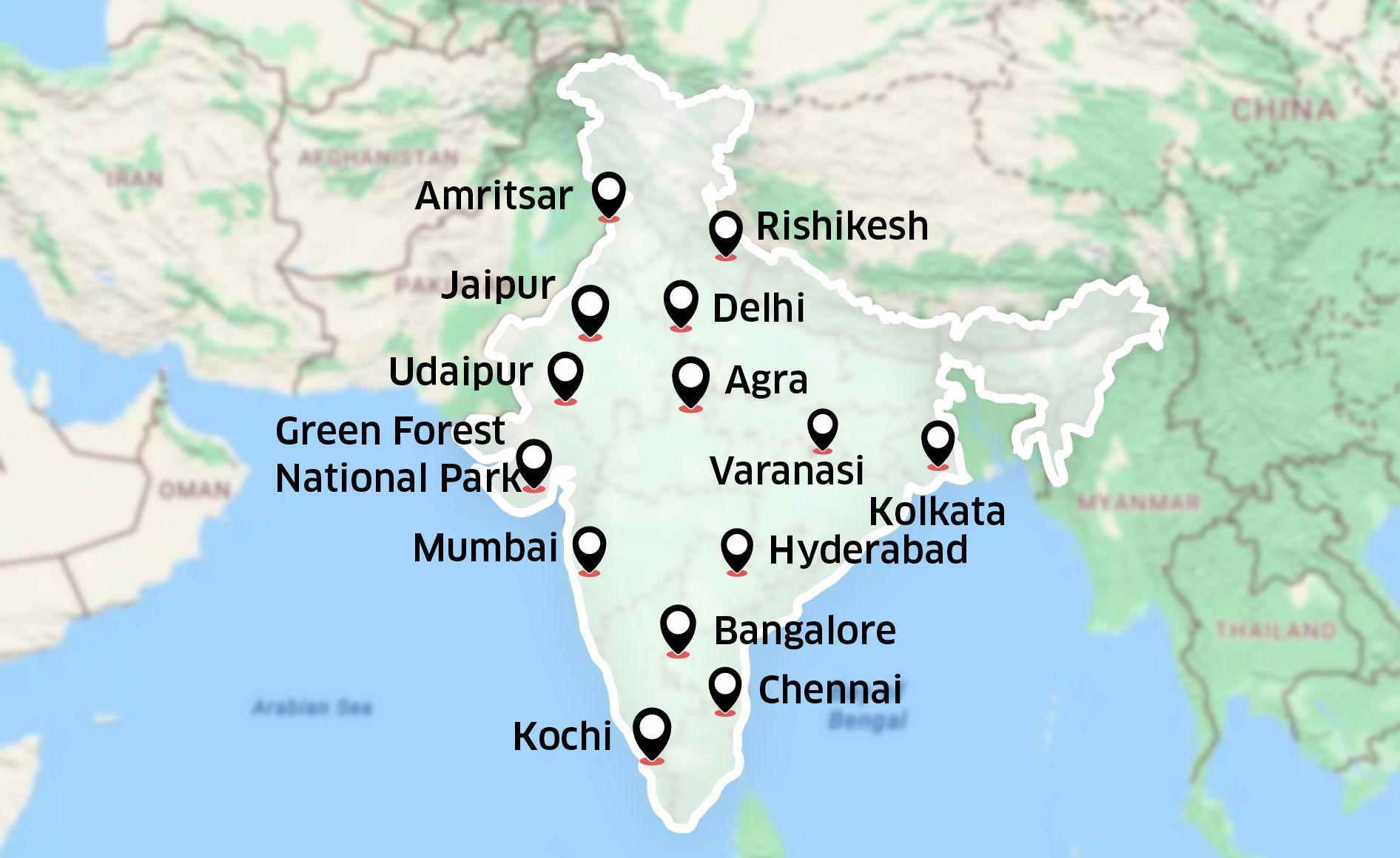

Welcome to India, a land of vibrant cultures, ancient heritage, and unparalleled diversity. From the majestic Himalayas in the north to the serene backwaters of Kerala in the south, India offers a rich tapestry of experiences. Discover iconic landmarks like the Taj Mahal, bustling bazaars, and spiritual sanctuaries. Our meticulously crafted journeys ensure you experience the authentic essence of India, making every moment unforgettable.

Agartala, the capital city of Tripura, is a vibrant and culturally rich destination in northeastern India. Nestled on the banks of the Haora River, it is known for its scenic beauty, lush greenery, and historical significance. Agartala is home to several magnificent palaces, including the Ujjayanta Palace, which showcases stunning Mughal architecture and now houses a state museum. The city's rich cultural tapestry is evident in its festivals, traditional dance forms like Hojagiri, and delectable cuisine. With its warm hospitality, bustling markets, and serene parks, Agartala offers a unique blend of tradition and modernity, making it a charming place to explore.
To travel to India, your passport must be valid for at least 6 months beyond your arrival date and have at least two blank pages for the visa stamp. A valid visa is required for entry, and most travelers must obtain it before their trip. An e-Visa option is available for citizens of many countries. Make sure to complete the application accurately and have your passport details and other required documents ready. Ensure your passport is in good condition, as damaged passports may be rejected by immigration. Additionally, verify that there are no travel restrictions or endorsements on your passport that could affect your entry. Always check the latest guidelines from the Indian embassy or consulate before traveling.
To travel to India, a valid visa is required for most foreign nationals, and it must be obtained before arrival. Common visa types include Tourist, Business, Employment, and Student Visas. India also offers an e-Visa for citizens of many countries, which can be applied for online and is available for tourism, business, and medical purposes. You can apply for this online through the official e-Visa website at https://indianvisaonline.gov.in/ Ensure your visa is valid for the entire duration of your stay, as overstaying can lead to penalties. Visa processing times vary, so apply well in advance. Visa on arrival is only available for a few nationalities under special conditions. Always check the latest guidelines from the link given above. Indian E-Visa allows a double entry with max 30 days stay in India. The traveller must enter India within 30 days of approval of E-visa otherwise the visa will be treated as cancelled. So please apply for E-visa within 30 days of arrival in India. The validty to remain in India will be counted from your day of arrival in India.
1. Check-in Baggage Allowance: The check-in baggage allowance depends on the airline, ticket class, and route. Typically, international flights allow 23 to 32 kg (50 to 70 lbs) per piece, while domestic flights within India often allow 15 to 25 kg (33 to 55 lbs). Check with your airline for specific limits. Mainly for domestic airlines it is 15 Kg except on some routes of Air India where it is 25 Kg.
2. Carry-On Baggage: The standard carry-on allowance is one bag weighing up to 7 to 10 kg (15 to 22 lbs) plus a personal item like a laptop bag or purse. The size limit is generally around 55 x 35 x 25 cm (22 x 14 x 10 inches).
3. Restricted Items: Items like sharp objects, flammable liquids, and certain electronics may be restricted in both checked and carry-on baggage. Review the list of prohibited items provided by your airline.
4. Customs Regulations: India has specific customs regulations regarding the import of goods. High-value items, large amounts of currency, or items like gold and electronics may need to be declared. Duty-free allowances vary for travelers bringing goods like alcohol and tobacco.
5. Baggage Security: Ensure your baggage is securely locked and labeled with your contact information. Avoid packing valuables in checked luggage and keep important documents, medications, and electronics in your carry-on.
6. Lost or Delayed Baggage: If your baggage is lost or delayed, immediately report it to the airline’s service desk at the airport. Keep your baggage claim tags handy for this purpose.
Always check the specific baggage rules of your airline before traveling to avoid any surprises at the airport.
The best time to visit India largely depends on the region you plan to explore, as the climate varies across the country:
1. Winter (October to March): This is the most popular time to visit most parts of India, especially the north, including Delhi, Uttar Pradesh, Rajashthan, Gujarat, South India including Kerala / Karnataka & Tamil Nadu region. In some part of North India the weather can be bone chilling during December / January & February and heavy wooken cloths are advised to pack while visiting Himalayan regions, Rajasthan & North India.
2. Summer (April to June): The summer months can be extremely hot, especially in northern and central India, with temperatures often exceeding 40°C (104°F). However, this is a good time to visit hill stations like Shimla, Manali, Kashmir, Leh & ladakh, Uttrakhand where the weather remains cooler.
3. Monsoon (June to September): The monsoon season brings heavy rainfall to most parts of India, particularly the west coast and southern regions. While the landscape becomes lush and green, travel can be challenging due to flooding and road conditions. However, the monsoon is a good time to visit places like Kerala and Goa if you enjoy the rainy season and fewer crowds.
For most travelers, the ideal time to visit India is during the winter months, from October to March, when the weather is comfortable for exploring the diverse landscapes and cultural sites.
The currency of India is the Indian Rupee, and abbreviated as INR. It is issued and managed by the Reserve Bank of India. Indian Rupees are available in both coin and banknote forms, with coins typically in denominations of Rs 1, Rs 2, Rs 5, and Rs 10, while banknotes are commonly available in denominations of Rs 10, Rs 20, Rs 50, Rs 100, ₹200 and ₹500. India's financial system supports a wide range of digital payments, and cash is still widely used, especially in smaller towns and markets. While digital payments and card transactions are increasingly common across India, particularly in urban areas, cash is still widely used, especially in smaller towns and rural regions. Travelers are advised to carry a mix of cash and digital payment options to ensure convenience throughout their journey.